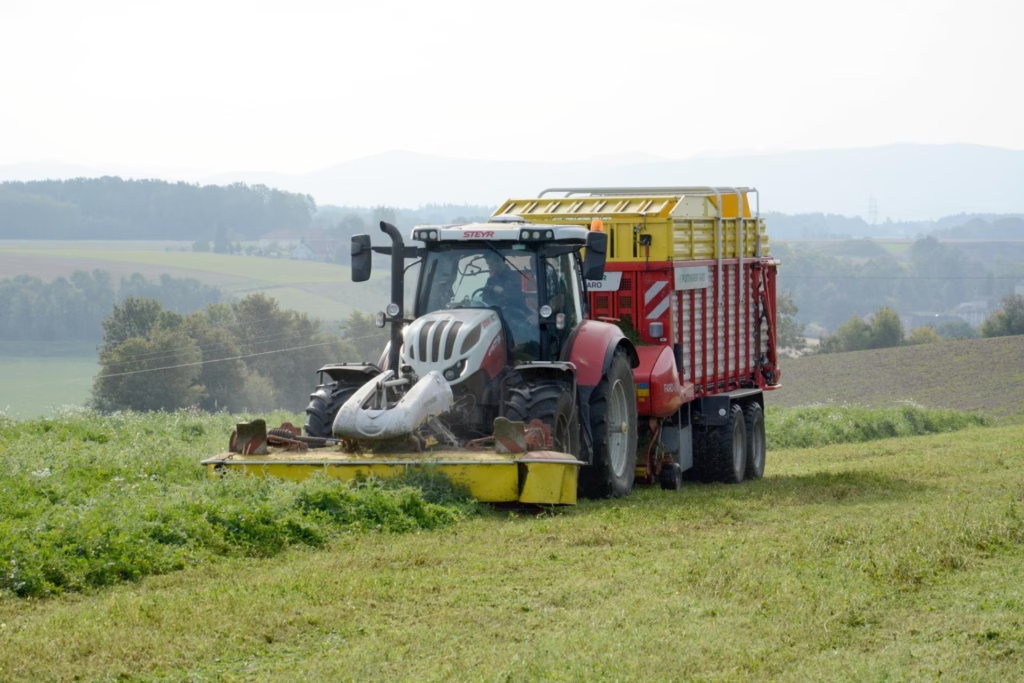An innovative pilot plant in Hofkirchen im Traunkreis uses renewable energies to gently process alfalfa and clover into high-quality protein feed.

In the "KleeKraftWerk" project, run by the Food Cluster of the Upper Austrian location agency Business Upper Austria, the energy efficiency of these feeds was optimized and the marketability of these feeds was examined. The calculations have shown that, when properly processed, alfalfa and clover are viable alternatives to traditional protein feeds such as soy.
In Austria and Europe, there is a shortage of protein feed for livestock, the so-called protein gap. The dependence on imported soy is ecologically and economically questionable. Clover and alfalfa offer a promising domestic alternative, as they provide twice the protein yield per hectare of soybeans while simultaneously improving soil health. However, there is currently no economically viable way to process these plants as protein feed.
Unused protein potential of alfalfa and clover
Currently, alfalfa and clover are primarily used as forage for ruminants and are only partially added to pig and poultry feed as crude fiber. The high protein content of these green plants cannot be utilized because only 40 to 60 percent of the protein can be preserved during processing into hay and green meal pellets.
Pilot plant with innovative process
In 2021, after several years of development, an innovative pilot plant with a novel process was put into operation in Hofkirchen im Traunkreis. This processing method preserves more than 80 percent of the protein. This transforms simple basic feed into a high-quality protein feed that can also be used as a protein ration in pig and poultry feed. The key difference from conventional drying plants is that the preservation process takes only two to five hours, not two to five days. Furthermore, drying takes place at temperatures below 50 degrees Celsius, which is extremely gentle on protein and other ingredients. The low drying temperature enables the use of primarily solar energy.
Solar energy used cleverly
The roof air extraction system, partially located beneath the semi-transparent PV array, delivers a large amount of high-temperature air, simultaneously cooling the PV modules. The PV electricity is used to dehumidify this air using the heat pump principle and feed it into the drying process. The 310 kWp PV system produces more electricity in a year than it consumes. The required residual heat comes from the wood chip stove. Thus, all the energy required on-site is generated from solar and renewable sources.
Optimized energy use
However, for more economical operation, energy efficiency had to be further optimized and drying time reduced. "We installed an energy monitoring system that records all relevant energy and production data in real time and makes it available as historical data. This enabled us to conduct a comprehensive analysis of the production facility," explains Josef Höckner, Managing Director of the plant manufacturer BioG GmbH.
50% less energy consumption
Measurements show that the use of dehumidification and roof air extraction can reduce energy consumption by up to 50% compared to conventional large-scale drying systems. On sunny days, roof air extraction alone contributes up to 30% of the drying energy from solar energy. Over a production year, this results in savings of approximately 150,000 to 200,000 kWh, or the equivalent of 175 to 235 srm of wood chips.
Automated and optimally controlled
"Automated energy control also offers great potential for optimization. In the complex energy mix of roof air, dehumidification, and furnace heat, the right switchover time plays a crucial role," explains Harald Dehner from the ASIC research group at the FH OÖ Forschungs & Entwicklungs GmbH on the Wels campus, which contributed its expertise to the project as a research partner. Based on defined environmental parameters, the system switches to the appropriate operating mode and uses dehumidification within the optimal temperature window.
Needs-based feed for better animal welfare
Alfalfa has long been known as a feed, but to date it has primarily been used in the ruminant sector. However, due to the special processing, the quality resulting from the KleeKraft process is not comparable to conventional green meal pellets. The protein quantity and quality, in particular, result in a feed that is also optimally utilized by poultry and pigs. "Our feeding trials within the project, as well as the supervised practical tests, confirm the recommended feed use. Many customers regularly order or pick up their feed directly from us – a clear sign of their satisfaction. The numerous rations we calculate daily also speak for themselves: They meet all ingredient requirements and remain either cheaper or at least the same price. This shows how well our concept works in practice," explains a delighted Manuel Böhm, arable farming and feeding consultant on the project.
